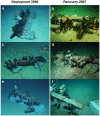How deep-sea wood falls sustain chemosynthetic life
- PMID: 23301092
- PMCID: PMC3534711
- DOI: 10.1371/journal.pone.0053590
How deep-sea wood falls sustain chemosynthetic life
Abstract
Large organic food falls to the deep sea--such as whale carcasses and wood logs--are known to serve as stepping stones for the dispersal of highly adapted chemosynthetic organisms inhabiting hot vents and cold seeps. Here we investigated the biogeochemical and microbiological processes leading to the development of sulfidic niches by deploying wood colonization experiments at a depth of 1690 m in the Eastern Mediterranean for one year. Wood-boring bivalves of the genus Xylophaga played a key role in the degradation of the wood logs, facilitating the development of anoxic zones and anaerobic microbial processes such as sulfate reduction. Fauna and bacteria associated with the wood included types reported from other deep-sea habitats including chemosynthetic ecosystems, confirming the potential role of large organic food falls as biodiversity hot spots and stepping stones for vent and seep communities. Specific bacterial communities developed on and around the wood falls within one year and were distinct from freshly submerged wood and background sediments. These included sulfate-reducing and cellulolytic bacterial taxa, which are likely to play an important role in the utilization of wood by chemosynthetic life and other deep-sea animals.
Conflict of interest statement
Figures








References
-
- Jørgensen BB, Boetius A (2007) Feast and famine – microbial life in the deep-sea bed. Nat Rev Microbiol 5: 770–781. - PubMed
-
- Turner RD (1973) Wood-boring bivalves, opportunistic species in the deep sea. Science 180: 1377–1379. - PubMed
-
- Smith CR, Baco AR (2003) Ecology of whale falls at the deep-sea floor. Oceanography and Marine Biology 41: 311–354.
-
- Gaudron SM, Pradillon F, Pailleret M, Duperron S, Le Bris N, et al. (2010) Colonization of organic substrates deployed in deep-sea reducing habitats by symbiotic species and associated fauna. Mar Environ Res 70: 1–12. - PubMed
-
- Baco AR, Smith CR (2003) High species richness in deep-sea chemoautotrophic whale skeleton communities. Mar Ecol Prog Ser 260: 109–114.
Publication types
MeSH terms
Substances
LinkOut - more resources
Full Text Sources
Other Literature Sources

